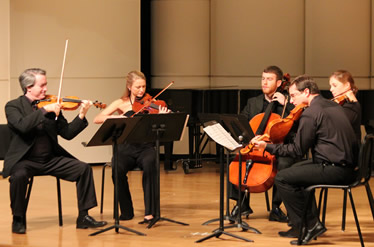It was supposed to be, in part, a celebration of the beginning of spring. A relatively small crowd hoped to escape the near-freezing, wet weather and enjoy a lovely program by the Chamber Orchestra of the Triangle (COT) at the Carolina Theatre in downtown Durham. Instead, the temperature inside was only marginally higher than outdoors and most of the audience needed to re-bundle themselves in their winter coats during the performance. This has happened several times before at this venue, so an inspection and maintenance of their HVAC system is in order.
This afternoon’s program was called “Love and Tragedy,” a phrase that some might think is unnecessarily repetitive. For the most part, the music selected was of a rather quiet, slow and sedate character. It also had a strong literary component as the works were based on the words of Shakespeare, Maeterlinck and Plutarch.
As a bonus, and aid in setting the mood, the guest artist was David Hammond who served as narrator. Hammond, former artistic director of PlayMakers Repertory Company in Chapel Hill, as well as an exhaustive list of other prestigious positions and experience, between movements read snippets from the corresponding works of these literary giants – mostly on the subject of love. While his theatrical air and authoritative voice added some gravitas to the performance, I’m not a big fan of this type of narration added to an orchestral performance and this one did not change my opinion.
The opener was one of the most celebrated orchestral works of Gabriel Fauré: his Suite from Pelleas and Melisande. Written as incidental music to the hugely successful play by Maurice Maeterlinck, it was well received in its 1898 premiere in London. It spawned other musical adaptations by Sibelius, Debussy and Schoenberg. In both the play and the music one could already hear the genesis of impressionism: a movement in art, music and poetry mainly developed by French artists that was all the rage shortly after the turn of the 20th century.
Lorenzo Muti, now in his 28th year as conductor and artistic director of the COT, led the orchestra in a sensually evocative and shimmering performance of this quasi-impressionistic gem. He masterfully controlled this four-movement balm of mostly gentle repose with subtle dynamic shadings. If there was a highlight it was probably the “hey, I’ve heard that” lovely Sicilienne that featured ethereal tone paintings by the woodwinds.
As a child my father had a recording of the famous Tchaikovsky “1812 Overture,” but more interesting to me was what was on the other side: “Othello Overture” by a weird guy whose name began with a “Dv!” Of course that was Antonin Dvořák and to this day there is nothing I have heard by him that I am not drawn to. This performance by the COT may be the only time I have heard it live, and it was worth the wait. In this, and the following Berlioz work, they definitely stretched the unwritten definition of the size of a “chamber” orchestra. Based on Shakespeare’s epic tragedy, this is an equally grand journey for any orchestra; and the COT, with its increased size and sound, was especially rousing, forceful and exciting in their playing. It’s interesting that despite the programmatic nature of the work, Dvořák still somehow managed to slip in that unmistakable Czech folk sound, and it all sounded appropriate. The brass section was especially impressive in their floor-shaking chordal unity and power.
Romeo and Juliet: Regardless of your age, artistic bent or any other affiliation, you’re going to have had some experience with this story. In Classical music it is probably Tchaikovsky’s overture or Prokofiev’s magnificent ballet score that is most widely known. For some perplexing reason, Hector Berlioz’s sprawling symphonie dramatique on Shakespeare’s profound love story has never quite reached the same public appeal as those two Russians’ works. Premiered in 1839, its length alone makes a complete performance quite rare, but today we heard nearly all of Part 2. This is sublime music with the mark of Berlioz imbued in nearly every phrase. Except for the celebration scene at the Capulets’ palace, this section of the score is predominantly slow, somber and as excellent a portrait of the “doomed lovers” that you will experience – in any medium. As any orchestral musician will tell you, this is the most difficult music to play and sustain a mood and interest in the audience. Muti brought out the long, lush lines and elevated this expanded ensemble to an emotional pitch that rivals anything I’ve heard.
The Armenian composer Aram Khachaturian wrote the music for a ballet based on the ancient slave Spartacus. The Adagio from Spartacus is all that is ever heard anymore and, depending on your preference, it is either a heart-tugging romantic epic or shameless schmaltz. But, you cannot deny the catchy sweeping theme and overall effect. Perhaps after the Berlioz emotional marathon – and even the very cold theater – the strings had some intonation problems for this final piece.
So while you might look at this as somewhat of a downer – cold rain outside, cold inside, the tragedies of love – it was enormously uplifting to again hear our remarkable Chamber Orchestra of the Triangle in another creative program performed at the highest professional level.












